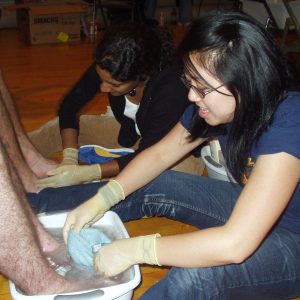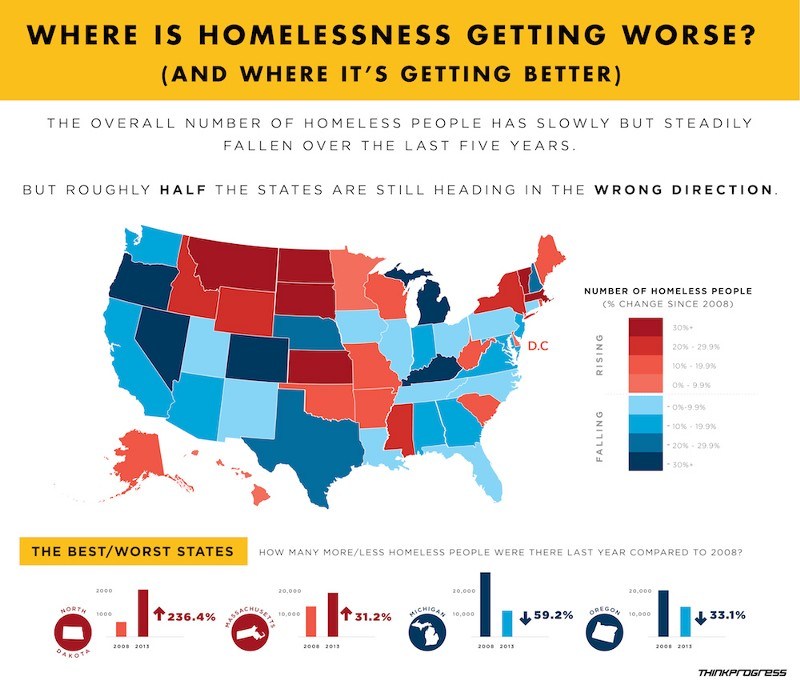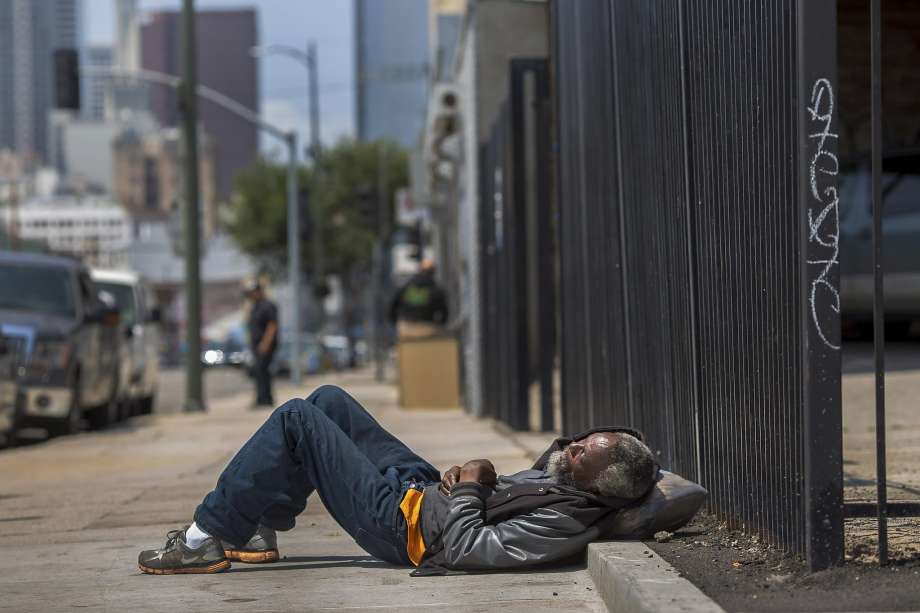
As the clock struck 7:00 pm, the homeless shelter on Dwight Way was thrown into the full swing of Tuesday night Womxn’s Clinic. Student volunteers from UC Berkeley’s Suitcase Clinic funneled in, followed, of course, by the ladies of the occasion, homeless females from every corner of the city.
I stood waiting in front of the foot washing station as ladies took their seats in a row of chairs; most were regular faces and a couple were individuals I saw sporadically every few weeks or so.
While I readied myself, a lady stumbled through the corridor and sat in the last seat—the Womxn’s Clinic director looked at me and remarked, “Dhruv, take care of her.” I placed a tub of water at her feet and promptly started to scrub her calluses. A few minutes in, I looked up at her as she sat mute and asked, “So, how have you been?”
When she began to tear up, I panicked. What did you just do? I thought. Oh no, I must’ve made her so uncomfortable. My internal dialogue aside, the only words I could get out were, “I’m sorry, is everything okay?”
Lips still trembling, she answered, “You’re the first person who’s actually cared to ask me how I’ve been in three months.”
That response still gives me goosebumps. That feeling of invisibility, constantly questioning the point of one’s existence, seemed so alien to me. I mean, how could I relate? I’m a college student of upper-middle-class socioeconomic status with a decent social life: life’s been great to me. Whether I’d like to admit it or not, I was a mere reflection of the bounty of my surroundings; the same can’t be said for the homeless. How often have you walked by an individual panhandling on the street? How often have you made eye contact with them? This aforementioned feeling of disenfranchisement isn’t alien; it’s reflective of the outdated legislation and societal stigmas that treat homeless people as complete outcasts.
There are distinct challenges to tackling the homeless issue though; simply tabulating them poses concerns. How do you count all the individuals staying in shelters, huddling under overpasses, or even living out of cars? Is it even possible to adjust for that level of vagrancy? Not only that but does the number of people without a place to live adequately portray homelessness in America? There are thousands of individuals living near the poverty line such that a bad paycheck or an increase in expense could throw them into financial insolvency. How do you account for that? Regardless of our best arguments of what metric works better than others, the simple fact is that 2016 data estimates by the National Alliance to End Homelessness reveal that more than 83,000 individuals nationwide are chronically homeless, doomed to suffer the burdens of economic disadvantage with no clear way out in sight.

Be that as it may, it would be willfully ignorant to forget that the society of today is heavily dependent on the policies of old. While homelessness has been persistent in American society for decades, the 1980s were especially tough on Americans below the poverty line. Post-war prosperity had long since stagnated, with the U.S. economy becoming entrenched in a period of deindustrialization, where wages were lowered across all fields, according to a 2007 report by the Inter-University Consortium Against Homelessness. With over 15% of Americans below the poverty line and a sharp increase in the number of homeless nationally, Congress introduced the first major piece of federal legislation addressed towards the issue of homelessness, the McKinney-Vento Act of 1987, passing it with bipartisan support. The act was one of the first of its kind, striving to provide funds to reorganize and provide funds to the U.S. Department of Housing and Development for emergency shelters, housing, job training, healthcare, drug rehabilitation, educational programs, and other related services.
Another development was the creation of the United States Interagency Council on Homelessness (USICH) in July of 1987. Since its inception, it has been tasked with coming up with sustainable strategies to combat the growth of chronic homelessness, promising to create a partnership at every level of government in the U.S. These policies and organizations became the bedrock of the U.S. government’s attempt to combat homelessness, specifically from an educational standpoint. With the passage of McKinney-Vento in 1987, the numerous potential benefits for homeless youth to receive an education and subsidized living were lauded by the public. Laurene Heybach, an attorney who argued an Illinois-state case to enforce the act, put it best when she remarked, “Each of our great civil rights struggles began at the schoolhouse door—race, disabilities, immigration, LGBTQ. Homelessness would be no different. [Finally] the structure, funding, teacher and staff buy-in, legislative commitment and research [had] grown.”
Almost as influential was the introduction of the assistance approach “Housing First” in 1988, as it became the main priority of both USICH and many similar advocacy organizations, such as the National Coalition for the Homelessness. The approach centered upon prioritizing permanent housing for homeless individuals over anything else considered less immediate, such as education and jobs searches. Housing First initially showed improvement, mainly benefiting individuals with mental disorders and substance abusers. In fact, New York, California and Pennsylvania all soon adopted programs with the hopes of significantly reducing their homeless populations; one program in Utah, now defunct, managed to house 2,000 individuals who were formerly chronically homeless.
But not all was as it seemed. Following the institution of the McKinney-Vento Act, the systemic issues surrounding the homeless and affordability arose. The growth of modern for-profit real estate complicated the search for affordable housing for individuals at the poverty line, leaving them without shelter. To make it worse, many cities have all but shut down shelter funding and construction, with cities like Los Angeles and New York City allowing 67% and 30% respectively of their homeless populations to fend for themselves on the streets while more and more shelters continue to be shut down as of August 2016. To compensate, the Department of Housing and Urban Development attempted to construct cheap housing projects in areas of low-socioeconomic status, mainly neighborhoods in New York, Pennsylvania, and Illinois, only for them to be torn down as soon as they were built, leaving many individuals homeless. City officials cite crime as the main culprit, attempting to sweeten the deal with false promises of newer developments with safer neighborhoods where the poor and middle class can coexist.
USICH, too, fell by the wayside, failing to sustain cooperation between most states on possible measures to end homelessness in America. Much of USICH’s failure came down to its lack of discretionary policy when it came to allocating funding and the disorganized spectrum of issues it was tasked with over the years, with its Opening Doors initiative (2010) expanding its range of efforts to healthcare management and crisis response systems. This combination of misdirection and reduction in federal funding, specifically a staggering 85% funding cut, has weakened USICH’s impact, so much so that the Trump administration plans to terminate the program altogether.
With these challenges seeming insurmountable, lawmakers attempted to depoliticize (Links to Paywall) the homeless issue, keeping it out of sight and mind. The formulation of the 10-Year Plan in 2000 by the National Alliance to End Homelessness placed numerous burdens on the process of aid application while under the guise of direct action. This involved the alliance, in many instances, denying the actual state of homelessness by mandating homeless counts take place during winter months when most homeless take shelter indoors. Another tactic lawmakers took was to decrease the accessibility of special services previously mentioned in the McKinney-Vento Act by including a high degree of client compliance within the process to receive aid. The need for regional agents to certify residence and employment status contrasted with the “frequent flyer” or vagrant mentality of many homeless individuals which exacerbated the issue further.

One predominant issue that made older legislation so unsuccessful was the many statutes put into place governing the homeless lifestyle, rather than attempting to integrate these disenfranchised individuals back into regular society. The institution of homeless job hiring quotas for businesses unfairly pitted the socially-underprivileged against the economically-disadvantaged, people considered out of circumstance versus people who seemingly had to fight to earn a living. This artificially-bred competition slowly eroded away any lasting sympathy for the homeless population by working-class Americans and employers alike. Recent reports by the National Coalition for the Homeless reveal that 70.4% of homeless respondents to annual surveys believe that they had been discriminated against by private businesses based on housing status. Adding insult to injury, the construction of low-income housing in middle-class neighborhoods alienated the same individuals that voted for homeless policy reform; as hard as it is to believe, statistics show that a majority of Americans, around 60%, agree the homeless require aid as well as should have further restrictions placed on their activities.
The facts don’t lie. Many Americans nowadays still don’t recognize the systemic challenges that homeless individuals face, believing that they are either on welfare or should still be able to one day achieve financial solvency. Studies coordinated by the Los Angeles Times showed that 44% of white Americans believed that the homeless were content with living on welfare, while the reality is that most families can’t afford most cities’ rising rents. In addition, most federal assistance programs haven’t supported the demand for aid simply because there is no mandate in place to all those facing financial insolvency; according to U.S. policy, housing is not an entitlement like, say, food stamps. Consequently, most government housing subsidies favor homeowners rather than renters, which, yet again, favors those at slightly higher income brackets.

While it’s important to identify faults in past policies, it’s important to build upon the responses to homelessness that have in fact worked. Federal housing programs such as the Housing Choice Voucher Program (2008) help individuals rent rather than buy, favoring flexible financial situations by providing qualifying families with assistance in paying rental fees for residential homes and apartments, not just in subsidized housing projects. In fact, states and cities can learn from Washington D.C.’s “Home for the Holidays” initiative, which is committed to countering soaring house prices that have contributed to a recent homeless crisis. By compiling and subsidizing housing in its “rapid rehousing” program, D.C. has managed to provide short-term rental assistance and services to homeless citizens, with the goals of helping people obtain housing quickly, increase self- sufficiency, and stay housed without draconian preconditions (such as employment, income, etc.) Overall, D.C. has managed to direct more immediate care to its homeless population more effectively than other cities. However, many high-cost cities implementing rapid re-housing have found that rents are not economically feasible for low-wage earners, and may be impossible to financially support for much of the homeless population, especially the unemployed and disabled. If anything, case studies in Seattle and other high-cost cities have shown that older methods of transitional housing may possibly outshine rapid rehousing, with one study boasting a 73% success rate in residence sustainability in Seattle communities using the transitional method. Regardless of the downsides, it would be foolish to underestimate the efficacy of rapid rehousing projects as potential solutions.
After my services were complete, the lady hurried out the door without another word; it was at that point I realized I never caught her name. And I still think about that now, all the possible connections that we could’ve made now lost because I didn’t take the time to show her I recognized her, that I saw her. The importance of federal policy and societal stigma aside, simply the recognition of an issue might be the biggest step of all.
So the next time you walk by someone sitting on the street, earning their keep, look at them. Acknowledge them. It’s a start: sometimes, the best way to help the homeless is to remind them they exist.
Featured Image Source: New York Times






Be First to Comment